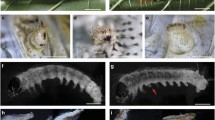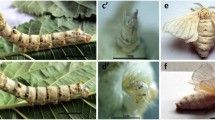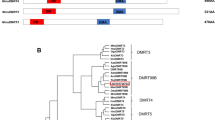Abstract
The formation of abdominal appendages in insects is suppressed by the Hox genes Ultrabithorax (Ubx) and abdominal-A (abd-A), but mechanisms of the suppression can differ among species. As the function of Ubx and abd-A has been described in only a few species, more data from various insects are necessary to elucidate the evolutionary transition of regulation on abdominal appendages. We examined the function of Ubx in the silkworm Bombyx mori (Bm-Ubx) by embryonic RNA interference (RNAi). This is the first case in which functional analysis for Ubx is performed in lepidopteran insects. Larvae treated with Bm-Ubx dsRNA displayed an additional pair of thoracic leg-like protuberances in A1, whereas the other abdominal segments had no transformation. Our results suggest that Bm-Ubx is a suppressor of leg development in A1.



Similar content being viewed by others
References
Angelini DR, Kaufman TC (2005) Insect appendages and comparative ontogenetics. Dev Biol 286:57–77
Angelini DR, Liu PZ, Hughes CL, Kaufman TC (2005) Hox gene function and interaction in the milkweed bug Oncopeltus fasciatus (Hemiptera). Dev Biol 287:440–455
Banno Y, Sakaida K, Nakamura T, Tsuchida K, Kawaguchi Y, Koga K, Doira H (1997) Reassessment of mapping of the E homeotic gene complex of Bombyx mori by linkage analysis and in situ hybridization with an Antennapedia clone as a probe. J Seric Sci Jpn 66:151–155
Castelli-Gair J, Akam M (1995) How the hox gene Utrabithorax specifies two different segments: the significance of spatial and temporal regulation within metameres. Development 121:2973–2982
Galant R, Carroll SB (2002) Evolution of a transcriptional repression domain in an insect Hox protein. Nature 415:910–913
Grenier JK, Garber TL, Warren R, Whitington PM, Carroll S (1997) Evolution of the entire arthropod Hox gene set predated the origin and radiation of the onychophoran/arthropod clade. Curr Biol 7:547–553
Hirokawa M (1998) Genetic analysis of a new mutant expressing extra-legs and extra-wings at the adult stage in the silkworm, Bombyx mori. J Seric Sci Jpn 67:1–7
Hughes CL, Kaufman TC (2002) Hox genes and the evolution of the arthropod body plan. Evol Dev 4:459–499
Itikawa N (1943) Genetical and embryological studies of a dominant mutant, ‘new additional crescent’, of the silkworm. Jap J Genet 19:182–188
Lewis DL, DeCamillis M, Bennett RL (2000) Distinct role of the hoeotic genes Ubx and abd-A in beetle embryonic abdomina appendage development. Proc Natl Acad Sci USA 97:4504–4509
Mahfooz N, Turchyn N, Mihajlovic M, Hrycaj S, Popadic A (2007) Ubx regulates differential enlargement and diversification of insect hind legs. PLoS ONE 2:e866. doi:10.1371/journal.pne.0000866
Morita A, Niimi T, Yamashita O (2003) Physiological differentiation of DH-PBAN producing neurosecretory cells in the silkworm embryo. J Insect Physiol 268:1093–1102
Ohtsuki Y (1979) Silkworm eggs. Japanese Society of Sericultural Science (ed) A general textbook of sericulture (in Japanese). Nihon Sansei Shinbun-Sha, Tokyo, pp 156–173
Palopoli MF, Patel NH (1998) Evolution of the interaction between Hox genes and a downstream target. Curr Biol 18:587–590
Pan MH, Wang XY, Chai CL, Zhang CD, Lu C, Xiang ZH (2009) Identification and function of Abdominal-A in the silkworm, Bombyx mori. Insect Mol Biol 18:155–160
Pavlopoulos A, Averof M (2002) Developmental evolution: Hox proteins ring the changes. Curr Biol 12:R291–R293
Ronshaugen M, McGinnis N, McGinnis W (2002) Hox protein mutation and macroevolution of the insect body plan. Nature 415:914–917
Suzuki Y, Palopoli MF (2001) Evolution of insect abdominal appendages: are prolegs homologous or convergent traits? Dev Genes Evol 211:486–492
Tazima Y (1964) E-group as a tool of developmental genetics. Tazima Y (ed) The genetics of the silkworm. Logos Press, London, pp 60–75
Tomita S, Kikuchi A (2009) Abd-B suppresses lepidopteran proleg development in posterior abdomen. Dev Biol 328:403–409
Tomoyasu Y, Wheeler SR, Denell RE (2005) Ultrabithorax is required for membranous wing identity in the beetle Tribolium castaneum. Nature 433:643–647
Ueno K, Hui C, Fukuta M, Suzuki Y (1992) Molecular analysis of the deletion mutants in the E homeotic complex of the silkworm Bombyx mori. Development 114:555–563
Vachon G, Cohen B, Pfeifle C, McGuffin ME, Botas J, Cohen SM (1992) Homeotic genes of the Bithorax complex suppress limb development in the abdomen of the Drosophila embryo through the target gene Distal-less. Cell 71:437–450
Warren RW, Nagy L, Selegue J, Gates J, Carroll S (1994) Evolution of homeotic gene regulation and function in flies and butterflies. Nature 372:458–461
Yasukochi Y, Ashakumary LA, Wu C, Yoshido A, Nohata J, Mita K, Sahara K (2004) Organization of the Hox gene cluster of the silkworm, Bombyx mori: a split of the Hox cluster in a non-Drosophila insect. Dev Genes Evol 214:606–614
Zheng Z, Khoo A, Fambrough D, Garza L, Booker R (1999) Homeotic gene expression in the wild-type and a homeotic mutant of the moth Manduca Sexta. Dev Genes Evol 209:460–472
Acknowledgment
We thank Dr. M. Kobayashi and Dr. M. Ikeda for productive discussions and express our gratitude to the National Institute of Agrobiological Science for providing silkworm strain No. 459. This study was supported in part by Grants-in-Aid from the Japan Society for the Promotion of Science.
Author information
Authors and Affiliations
Corresponding author
Additional information
Communicated by S. Roth
Electronic Supplementary Material
Below is the link to the electronic supplementary material.
Fig. S1
The nucleotide sequence (top) and deduced amino acid sequence (bottom) of Bm-Ubx cDNA from B. mori. Arrows indicate primer sequences used in RACE and RT-PCR (See "Materials and methods"). Double underline indicates homeobox. Boxed nucleotides represent a putative polyadenylation signal (AATAAA; GIF 138 kb)
Rights and permissions
About this article
Cite this article
Masumoto, M., Yaginuma, T. & Niimi, T. Functional analysis of Ultrabithorax in the silkworm, Bombyx mori, using RNAi. Dev Genes Evol 219, 437–444 (2009). https://doi.org/10.1007/s00427-009-0305-9
Received:
Accepted:
Published:
Issue Date:
DOI: https://doi.org/10.1007/s00427-009-0305-9




